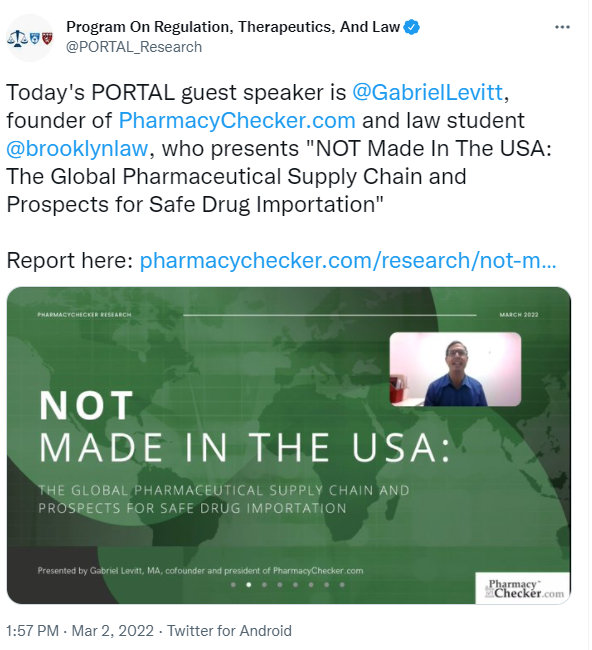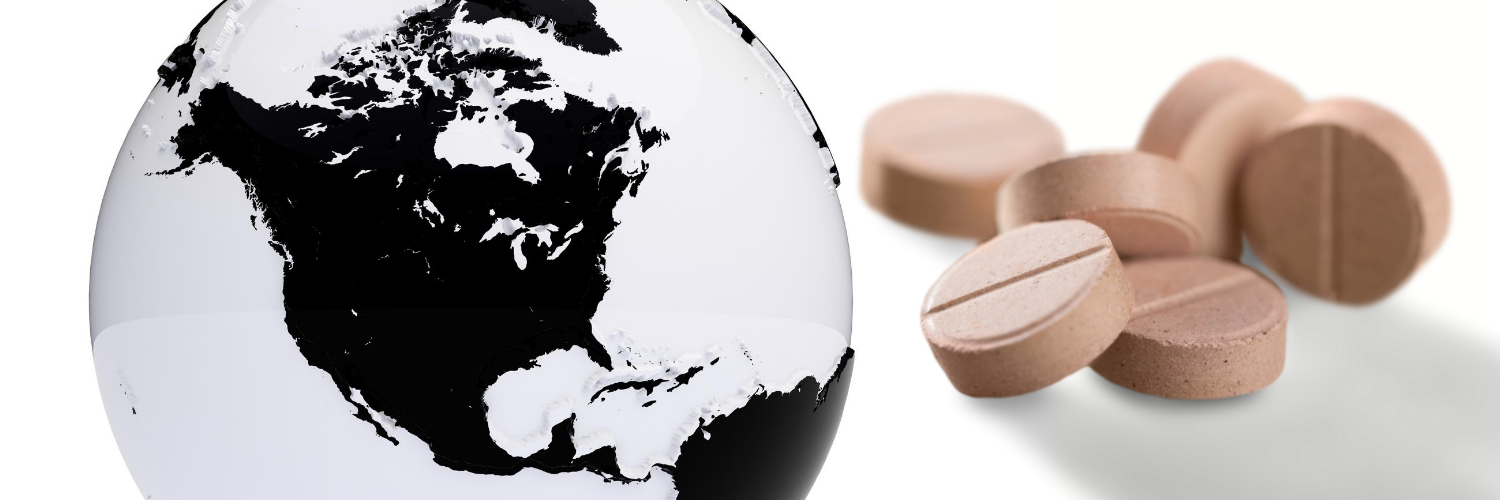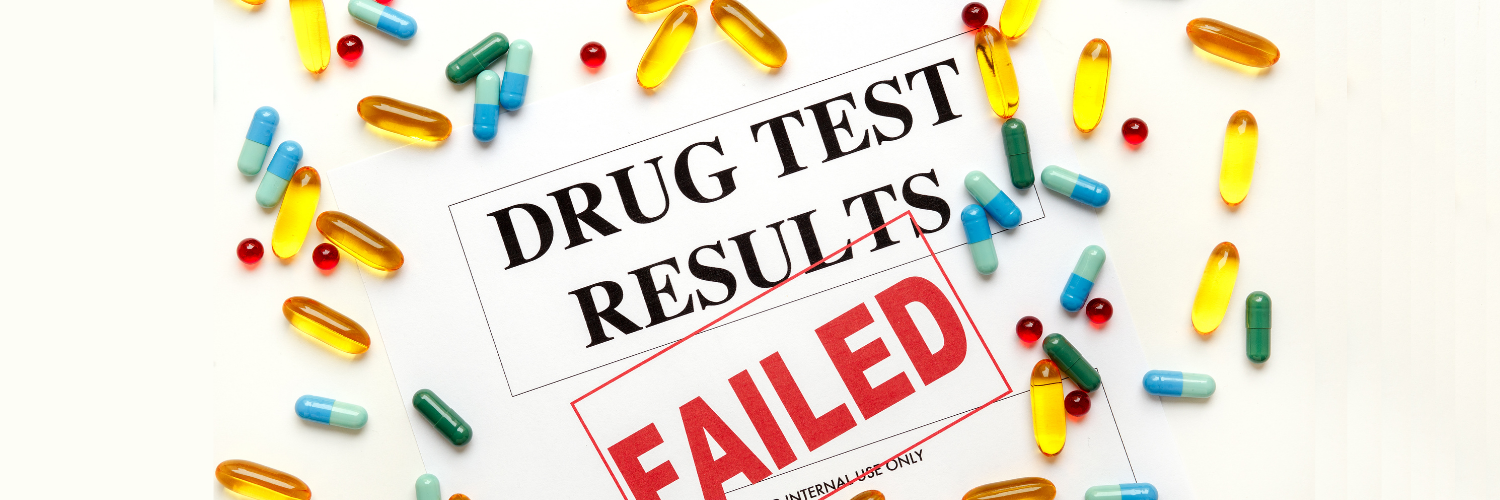PORTAL Research Group Guest Speaker Gabriel Levitt Presents “Not Made in the USA” Key Findings

On March 2nd, PORTAL (Program On Regulation, Therapeutics, And Law) Research, led by Dr. Aaron Kesselheim, MD, JD, welcomed Gabriel Levitt, president and co-founder of PharmacyChecker.com, as the meeting’s guest speaker. Gabe’s presentation highlighted the findings in the PharmacyChecker Research report, “Not Made in the USA: The Global Pharmaceutical Supply Chain and Prospects for Safe Drug Importation,” and, afterward, he fielded questions from members.
PORTAL’s research group membership spans the fields of medicine, law, epidemiology, and health policy with an aim to evaluate emerging issues on the regulation, use, and reimbursement of prescription drugs and medical devices. Its parent organization is the Division of Pharmacoepidemiology and Pharmacoeconomics of Harvard Medical School and Brigham & Women’s Hospital.
Levitt explained the distorted reality of personal and wholesale prescription drug importation in the United States, saying that pharma industry sound bites dictate that so-called “foreign drugs” are unsafe despite many of the medications we buy at local pharmacies being these “foreign drugs” (i.e., foreign made). Federal law highly restricts drug importation for resale, but millions of Americans personally import their prescription drugs each year in order to afford them. Flawed beliefs, pharma mythmaking, and FDA bureaucratic self-protection prevent larger-scale, practical policies from being implemented surrounding lowering drug costs in the United States via importation.
A loose transcript of the presentation sans introduction and Q&A is posted below.
“For at least 20 years, pointing to FDA data, the U.S. Government Accountability Office (GAO), the media, think tanks, consumer periodicals, academic journals — you name it! — have regurgitated the figure 80% in reference to the percentage of active pharmaceutical ingredients imported to make prescription drugs for the U.S. market.
During that same period, U.S. drug supply chains were time and time again described as “increasingly global.” Then, how is it that this 80% figure remained unchanged for over two decades? Another statistic, that 40% of finished drug formulations are foreign-made, had circulated for at least a decade.”
In 1997, and again in 2019, the GAO referred to this same statistic from the FDA. Another statistic, that 40% of finished drug formulations are foreign-made, had circulated for at least a decade.
Finally, after many years, a report in 2019 by the Congressional Research Service rightfully questioned the data: “A frequently cited figure is that 80% of APIs are made overseas, although questions remain about the origin of this figure.” So, let's look at some real data.
We found that a large majority, not 40%, of brand medication products sold in the U.S. are produced outside the U.S.
In 2018, 68% of finished drug products and 78% of active pharmaceutical ingredients of the top 100 Medicare prescription drugs by total expenditures sold in the United States were imported.
Our dataset consisted of the top 100 drugs by total spending in Medicare Part D in 2018. Where there were generic drug names listed, we looked at the brand name product to assess the manufacturing origin of that drug. Eighty-five of the 100 were single-source drugs with no generic availability in 2018.
When it comes to the topic of foreign-made drugs, manufacturing, safety and quality issues, and even national security supply vulnerabilities, the focus is usually on generic drugs. Our paper begins to fill a research gap. Examining and understanding the supply chain and country origins of brand name drugs, is important:
You'll notice the phrase "FDA-Defined" at the top of this slide.
Similar to generic drugs, most brand FDFs and their APIs are foreign made. What differs is that most FDA-approved brand name drugs, including their APIs, are made in high-income countries with strong pharmaceutical regulations. Of the 100 Medicare Part D drugs assessed in our report, 32 were finished in the U.S.; 67 were finished in countries that have comparable to if not stronger systems of pharmaceutical manufacturing than the U.S.: the countries in the European Union, Canada, Japan, Singapore, Switzerland, and the United Kingdom.
One drug, brand Neurontin (gabapentin), was formulated in India.
Here you see the phrase, "CBP-Defined.”
78% of the 100 drugs examined were formulated with foreign-made APIs.
98% of the drugs assessed were made in countries that have comparable if not better systems of pharmaceutical regulations to the U.S.
The exceptions to that were Neurontin and Imbruvica.
Neurontin's label reads that it is “Made in India,” indicating that both the API and FDF are manufactured in India. Gabapentin is widely available in the U.S. as a generic.
Imbruvica's label reads “Active ingredient made in China.” A drug company representative said that “the manufacturing, testing, packaging [of Imbruvica] is done across multiple locations in the USA. This indicates that the API is manufactured in China and the FDF, in the USA.
There are three main takeaways that informed our policy recommendations.
As I've mentioned, almost all imported brand name drugs are made in countries with manufacturing safety practices equal or superior to those in the United States. And most of those countries are considered democratic allies of the U.S.
Of those drugs from the dataset that are accessible online, average international mail order prices were 75.53% lower than average U.S. pharmacy prices. Average prices available of drugs only shipped from Canadian dispensing pharmacies were 70.18% lower than average U.S. pharmacy prices.
On many prescription bottles dispensed throughout the U.S. it’s not clear where a drug is made. But often the original manufacturer’s label is clear, as is the case with Januvia.
But you’ve got to look! It says Sitagliptin, active ingredient made in Italy. There’s your API. Formulated in the UK. There’s your finished drugs. Much of country data was directly from these labels.
Is Januvia imported from Italy or the UK? Depends what agency you ask.
1. FDA regulations alone don’t require transparency about where a drug is made, but the Misbranding statute requires truthfulness in labeling. Thus, because of the Tariff Act, an imported drug label would be misbranded without meeting the labeling requirements of the Tariff Act.
2. Just 22 out of 100 drugs in our dataset listed only a U.S. address shows starkly how foreign our drug supply really is.
3. Add to that just two of the 100 drug labels we looked at claimed: “Made in the U.S.A.”
4. Prescription bottles with loose pills dispensed in the pharmacy, don't have the same country of origin information as the manufacturer's label, but they should.
Our primary research and data looked for the percent of branded prescription drug products that are foreign made and imported, not the volume of bulk pharmaceutical imports. This chart shows Commerce department trade data as compiled by Public Citizen in 2019. Public Citizen’s purpose was to show how dominant China is in exporting pharmaceuticals to the U.S. These bulk pharmaceutical imports include over-the-counter as well as prescription pharmaceuticals. We included this information in our report because the data complements our own data.” These figures show that brand name drugs come from high income-countries, APIs and finished formulations. Imports from Ireland are a quintessential example. Pharmaceutical imports from Ireland account for only 2.76% of the import volume of the top 10, but 38% of the dollar value -- almost $30 billion. That reflects the much higher cost of brand name vs. generic drugs. The inverse is true of China: pharmaceutical imports from China account for 22.46% of the top 10 countries, but only 2 of the dollar value: about $1.6 billion.
In addition to showing the countries of origin, our paper compared prices of those drugs in our dataset that are available for sale online from PharmacyChecker-accredited online pharmacies, ones that process orders for prescription drugs dispensed by international mailorder. These include products sold in Australia, Canada, India, Israel, New Zealand, Turkey, or the UK.
This chart shows prices for three months supplies of the prescription drug: U.S. price, lowest international prices, and Canadian price.
Notice Eliquis is over $1600 in the U.S., about $450 in Canada, and the international price is about $300.
Our data are retail prices. We compared our findings to a more robust analysis of comparative international drug pricing at the wholesale level from the Rand Corporation, and our findings corresponded strongly.
We found that Not Made in the U.S.A: Top brand name drugs are 75.53% lower-priced outside the U.S. at international mail-order pharmacies.
Rand Study: For the top 60 drugs by sales in Rand’s study, wholesale prices were about 75% lower outside the U.S.
In the debate about importation and drug safety, the pharmaceutical industry's mantra is that the FDA is the gold standard in safety. That's not what FDA's data shows when it comes to manufacturing.
The authors of this paper come from the FDA Center Drug Evaluation and Research. "Quality Testing of Difficult-to-Make Prescription Pharmaceutical Products Marketed in the U.S."
Dr. Janet Woodock is an author. 252 drug samples, 35 innovator and 217 generic, made in the U.S., Canada, Europe, India, Other Asian countries, were tested. Key takeaways are as follows.
1) All samples met U.S. FDA standards for dosage uniformity and dissolution.
2) However, in contrast to the perfect results for innovator drug quality, 11 generics scored lower on the PPK index for dissolution, process performance index, below the 4-sigma capability.
3) The U.S. performance was below average. Quoting from the report, "The process performance index suggests that US manufacturers made some of the generic drugs sampled here with comparable, if not slightly lower, consistency than Indian and Asian manufacturers."
Let's review the key takeaways.
1. The U.S. is Not the Gold Standard. Europe is the gold standard.
2. European drug manufacturers, according to the FDA, have a superior track record to their U.S. counterparts in cGMP compliance
3. Brand name drugs are on average of higher quality than their generic counterparts.
If it's a fact that imported brand name drugs do not represent any additional public health risk, then we must look to bold public policies towards ending Big Pharma's distribution monopoly on these brand name drugs.
In accordance with Section 801 of the FDCA, FDA issued guidance to allow drug manufacturers to create new NDC numbers for what they call Multi-market Authorization (MMA) drugs: drugs manufactured outside the U.S. that are authorized for sale in the U.S. and other countries. Drug companies were telling the FDA that they were locked into higher prices because of 3rd party agreements with PBMs, but would like to sell drugs at lower prices in the cash market. So the FDA called their bluff and issued this guidance that essentially makes it easier to circumvent these PBM higher prices by slapping different NDC numbers on MMA drugs that were going to be sold elsewhere but now will be sold in the U.S. As I understand it, drug companies haven't been availing themselves of this opportunity.
Section 804 is that part of the FDCA that makes wholesale importation legal IF the HHS Secretary determines that there's no additional risk to public health and American consumers will save money.
That certification was made by former HHS secretary Alex Azar in the fall of 2020, which made me believe that pigs may in fact fly.
Section 804 and the final rule have many limitations. One, it's just for importation from Canada. Two, biologics cannot be included. Three, imports must come from a wholesaler in Canada that received the drugs directly from the manufacturer, which makes it easy for drug companies to restrict supplies. Adding insult to injury, the Canadian government has instituted rules for Canadian wholesalers that protect Canadian drug supplies from being sold at higher prices to the U.S.
Long story short: a final rule has been issued that appears focused on creating a pathway for states that have passed drug importation laws to create importation programs to move forward. But that has not happened. Colorado and Florida both have submitted somewhat detailed proposals but are still waiting.
The law allows for patients to use personal importation. Congress states that the Secretary "Should...exercise enforcement discretion to permit" personal drug importation. It's my hope that you as healthcare providers explore this channel of access to much more affordable medicine for your patients.
The recommendation here is to allow imports of lower-cost, foreign versions of FDA-approved drugs, mostly when a shortage exists in the U.S., but also in cases of when off-patent drugs are subject to severe price hikes. The most notorious example of that is Daraprim in 2015. Fun fact: when Martin Shkreli hiked the per pill price from $13.50 to $750 overnight, the price in the UK for brand name Daraprim was about $5. The U.S. drug was made by a contract manufacturer in domestically, the UK drug was made by Glaxo.
The European Union has safe parallel trade in pharmaceuticals and it helps lower the cost of patented drugs. I recommend a future where the U.S. avails itself of this highly regulated and secure pharmaceutical marketplace.
"The global supply chains for brand name pharmaceuticals in other high-income countries allow for dynamic and safe parallel trade that would serve to substantially lower drug prices in the United States. The extent to which our drug supply relies on importation currently is enough to warrant serious reforms in the U.S.; that is to allow businesses, other than drug manufacturers, the ability to import drugs at lower prices from countries beyond Canada, most importantly from the European Union."
It's not enough to accept industry capture at the FDA. It should be overcome and will be at some point, probably by the work that you are all doing.
One final note. I'm equally in favor of Medicare drug price negotiation as a serious effort to tame patented drug prices -- and want to put out there that importation and drug price negotiations are not mutually exclusive.





